Becky Shindell A Business’s Worst Nightmare #semrushchat … Wow-Score collecting now The Wow-Score shows how engaging a blog post is. It is calculated based on the correlation between users’ active reading time, their scrolling speed and the article’s length. Learn more A Business’s Worst Nightmare #semrushchat
- 60
- 13
- 12
Halloween is almost here, are you ready? In anticipation of all Hallow's Eve, we decided to talk about the type of nightmares that all businesses have — from empty sales funnels to no brand loyalty and other spooky things. In order to turn these nightmares into a sweet dream, we invited Hotjar, an awesome analytics tool that helps you to better understand your web and mobile site visitors.
During the chat, our guests answered the following questions:
-
For your business specifically, what would you classify as a business nightmare?
-
How do you react and what do you tell your clients, if your marketing strategy fails?
-
What steps do you take to recover and re-engage your audience, if your site crashes during a big promotion?
-
All search traffic that comes to the website pages is untargeted and doesn't convert. What can be done?
-
What do you do, if your CTA isn’t getting any traction?
-
Which web design elements and CTAs scare the customers away the most?
Q1. For your business specifically, what would you classify as a business nightmare?
We collected tweets with some real business nightmares in different industries:
A1.) unexplained funnel drop-outs and checkout payment failures #semrushchat
— Ryan Glass (@RyanGPhx) October 25, 2017
A1 If all our websites went down at the same time – there would be chaos! #semrushchat
— Base Creative London (@basecreative) October 25, 2017
A1: If a competitor came out with a product out of nowhere that completely disrupted our industry #semrushchat
— Kevin_Indig (@Kevin_Indig) October 25, 2017
A1: Google going out of business #semrushchat pic.twitter.com/BJ9LvKhOXy
— Rachel Howe (@R8chel_Marie) October 25, 2017
A1) Clients who trust their inept devs more than trusted SEOs #SEMRushChat https://t.co/TpAAf3YaQL
— Dawn Anderson (@dawnieando) October 25, 2017
A1: Massive amounts of spend and resources attracting traffic that doesn't convert. #SEMRushChat https://t.co/47l52n1kVa
— Scott Robertson (@esseaoh) October 25, 2017
a1) People who make decisions based on feelings rather than data ("ego-driven" decision making) #semrushchat
— Ryan Johnson (@rsj8000) October 25, 2017
A1: Somehow if everyone decided video wasn't a good marketing strategy. #semrushchat pic.twitter.com/BFQj7uXz9T
— Chris Bryant 🎥 (@The_ChrisBryant) October 25, 2017
A1. My client's did a disavow on all the best backlinks they had #semrushchat https://t.co/EhldnNYTsx
— Peter Mead (@petermeadit) October 25, 2017
A1: If all of a sudden no-one ever did anything wrong and Google released the inner workings of their algorithms 😀 #semrushchat
— Andy Drinkwater (@iqseo) October 25, 2017
A1: Our biggest nightmare would be a client-pocalypse. I.e., Non-paying clients rise from the SERPs to feast on our sales! #semrushchat https://t.co/9U2ZksYDvf
— ThinkSEM (@ThinkSEM) October 25, 2017
A1: One nightmare is having a workspace that doesn't encourage collaboration or having departments that don't work together. #Semrushchat
— Danny Ray Lima (@dannyraylima) October 25, 2017
A1 – A big business nightmare is when #SEO is considered "just" as an onpage work (H1, ALT-tags, Internal links). 🙄 #semrushchat
— Fanny Heuck (@FannyHeuck) October 25, 2017
This last one is probably one of the most dreadful nightmares that we can ever imagine in any business:
A1: The day we stop treating our users as our only priority! User satisfaction is our bottom line. #semrushchat
— Hotjar (@hotjar) October 25, 2017
Next, we decided to dwell on some of the problems that business owners may face and discuss how to successfully overcome these nightmares.
Q2. Let’s say your marketing strategy for a client failed. How do you react and what do you tell them?
1. Determine Why Your Strategy Failed
Take time to figure out why your strategy didn't work out as planned. Maybe it happened because you didn't identify your proper persona, or you didn't have enough resources, or you didn't set the right realistic goals. While there could be a plethora of reasons, you need to determine why your strategy failed so that you can understand what you can do to create a better plan.
A2: First, determine why your strategy didn't work. Next, figure out how to alter the plan for future success. #semrushchat
— Netvantage Marketing (@netvantage) October 25, 2017
2. Use Data
By using a data-driven approach, you can identify which strategies are most likely to be successful. If your campaign doesn't work, apply science and utilize analytics to understand why it happened. If you accumulate and analyze data on your user behavior, you can build a campaign that really works.
A2: You try your best to discern why with data & examples. Have a new plan and explain your rational for pivoting (again, data) #semrushchat
— Thom Craver (@thomcraver) October 25, 2017
Don’t forget to test. Try something completely different and run a small campaign (a pilot) and monitor and analyze the results of your work. Testing is very effective to help you to determine how your campaign will play out before launching a large, expensive project. The “test and learn” approach allows for continuous improvement and can help you to raise the effectiveness of your campaign.
A2: In all seriousness, it really is test & find what works. Now u know what doesn't work, do more of what does work. Reflect. #semrushchat
— Rachel Howe (@R8chel_Marie) October 25, 2017
3. Don’t Panic and Be Honest
Mistakes happen, even to the most successful marketers. However, those who don't give up and are committed to fixing their mistakes have the opportunity to be successful in this industry. Don’t try to conceal your failure and always be honest with your clients, otherwise, sooner or later your deceit will be revealed and the consequences could be much worse.
A2: If your strategy failed, don't panic. Tell your client and then propose a new plan to implement moving forward. #semrushchat
— Express Writers (@ExpWriters) October 25, 2017
A2: Honesty is the best policy, so I think it's always good to be upfront and show your commitment toward fixing the problem #semrushchat
— Deren Baker (@deren_baker) October 25, 2017
A2 be honest about what failed and where the strategy could be adjusted in the future. Build trust as a partner, not a vendor #semrushchat
— Sean Bucher (@spbucher) October 25, 2017
“Failure is a step towards success. Successful marketing strategies take an iterative approach,” tweeted Hotjar – @hotjar.
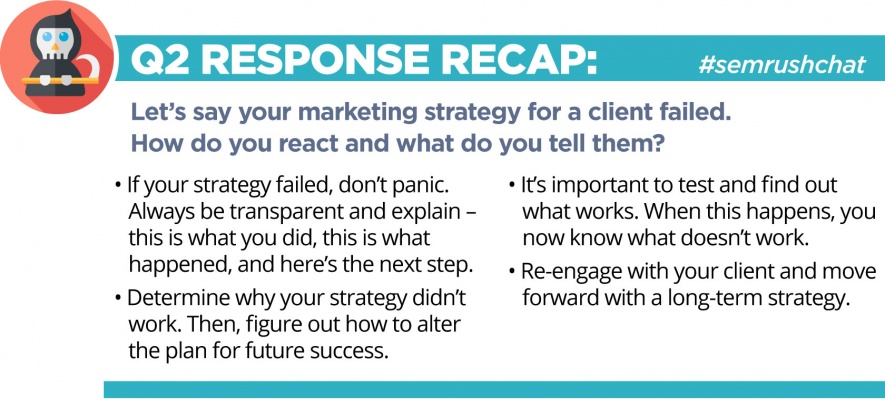
Q3. Your site crashes during a big promotion. What steps do you take to recover and re-engage your audience?
1. Show That You Acknowledge the Situation
If you have an email list, you can write a brief notice to inform your audience of the blackout. Let your customers know that you are aware of the situation and are taking the necessary steps to resolve the issue; this will demonstrate that you care about your customers.
A3: 1. Make it known that you're aware of the issue & solving it. 2. Share an additional deal or extend the current deal. #semrushchat
— Netvantage Marketing (@netvantage) October 25, 2017
A3. Keep audience informed. Post ad when fixed, give extra incentive for inconvience, extend promo period #semrushchat
— Juls (@JULScf) October 25, 2017
2. Engage With Your Audience on Social Media
Social media remains a great place for businesses to connect with their audience. If your site crashes, you can turn to the social media platforms that your users usually spend their time on and respond there. This way, you can let people know that you are available for questions and concerns, even if your site is down.
A3: Again, be honest, engage on social media with customers as needed, and don't rest until the problem is solved #semrushchat
— Deren Baker (@deren_baker) October 25, 2017
3. Apologize
This may sound obvious, but, some site owners forget about this simple, yet still crucial step. Show people respect and make an apology for the temporary inconvenience. “Leverage your social followers and email lists to apologize and inform. Treat customers like you would want to be treated!” tweeted Thom Craver – @thomcraver.
a3) 1 Analyse the cause. 2 Fix the cause asap. 3 Re-engage through retargeting and newsletters and say sorry. Last is important #semrushchat
— Lucas Vos (@lucasvos) October 25, 2017
4. Stop Online Ads
If you are running an online advertising campaign, don’t forget to stop it to avoid wasting your money on ads that don’t deliver desired results. Otherwise, your users will be annoyed when they land on a blank page, and you will end up paying money with no return.
A3. Find a good solution and learn from the experience! Also, don't forget to pause and Paid ads! #semrushchat
— clockworkTalent. (@clockworkTalent) October 25, 2017
5. Offer Compensations
Aside from making an apology, you can also offer your users some kind of compensation or freebie. Contact them on social media or other channels to let them know that you want to make up for the inconvenience, while you are fixing the issue; this will make them feel valued. “If your site crashes, put a notice up, fix it fast, then offer some incentives for folks to come back again,” recommended Peter Mead – @petermeadit.
A3: 1. Be transparent about the reasons. 2. Offer compensation/freebies. 3. Move to social or other channels. 4. Tequila + fix #semrushchat
— Adriana Tica (@adriana_tica) October 25, 2017
A3: 1) Embrace uncertainty 2) Be transparent 3) Pause paid campaigns 4) Update users regularly 5) Fix it#semrushchat
— Hotjar (@hotjar) October 25, 2017
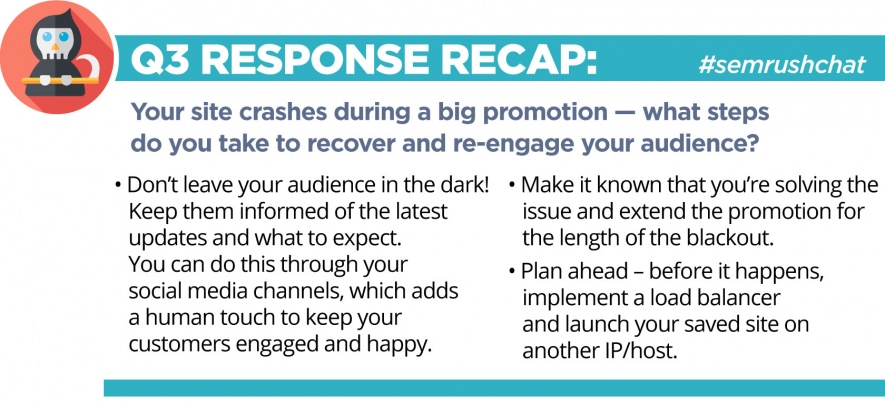
Unfortunately, many website owners have to go through this daunting experience. However, the steps our chat guests mentioned will help you remedy the problem, when/if it occurs.
Q4. All search traffic that comes to the website pages is untargeted and doesn't convert. What can be done?
When you analyze your website traffic and don’t know where some part of it comes from, this traffic is likely to be untargeted, which means that users come to your website with zero interest in what your business has to offer. As a result, there is only a small chance that this traffic will convert. Here are some tips to resolve this problem:
Find Out What Site Elements Make Visitors Drop Off
Successful marketers take their time to focus on conversion optimization. Running a solid CRO strategy means that you analyze users who don’t convert and invest your efforts into making them subscribe, follow, or buy, depending on your goals. It includes a thorough process of research, analysis, and optimization in order to figure out what pages make your visitors drop off and then identify elements that prevent them from converting.
Make sure to test and run experiments to determine what works and what doesn’t. A/B testing, also known as split testing, is a powerful tactic to find out what’s wrong with your page, and more importantly, what should be done to improve conversions.
A4. Find out what page they dropped off on so you know where to optimize, check your demo report, & set up targeting!! #semrushchat pic.twitter.com/lj5NCp1f1n
— Sarah B (@SarahAHolder) October 25, 2017
Rethink Your Keyword Research Strategy
Acquiring the wrong type of traffic is one of the main reasons for low conversions because the keywords you use may drive the wrong type of audience to your site. For example, if your customers are entrepreneurs, but your keywords are attracting college students, your traffic likely will not convert. It is important to learn how your potential clients are searching for you and your competitors, as well as how the search engines view your site. “Review your keyword list and Google Analytics data, identify what search terms are triggering traffic and make necessary updates to improve,” suggested Danny Ray Lima – @dannyraylima.
A4: Rethink your keyword research. Make sure you have compelling CTAs throughout your pages #semrushchat
— Rachel Howe (@R8chel_Marie) October 25, 2017
Improve Your Calls to Action
When someone lands on your website, only half of your work is done. You need to persuade these people to choose you from your competitor's websites, which is where a good call to action can help. Its main function is to make your site visitors take a specific action right off the bat, and an effective CTA helps you to communicate the value of your brand to your site visitors. You need to make sure that your CTA is visually appealing, engaging, and compelling. You can check out these 16 hacks for getting your CTA buttons clicked by Neil Patel.
a4. Re-evaluate your CTAs, micro and macro, for relationship and content support. Go thru funnel yourself to catch pain points.#semrushchat
— “Slayer” Sweeny (@msweeny) October 25, 2017
Learn more about your site visitors
When you discover that your site visitors aren’t your true audience, you may ask yourself: “What are they looking for on your site?” Our special guest recommended asking for their feedback. For example, you can use a feedback form or a live chat feature to let people tell you what they were expecting to see on this page; this will provide some great insights into who your site visitors really are.
A4: Nothing beats 🥊 asking people directly. “What did you expect to find on this page?”, You'll be surprised what you find! #semrushchat
— Hotjar (@hotjar) October 25, 2017
Build a Conversion Funnel and Create Interest
As Bill Slawski – @bill_slawski pointed out, a strong marketing campaign should create targeted interest. To turn your non-converting traffic into significant conversion improvements, you need to refresh your conversion funnel or build it. If you don’t have one, you should focus on it because it helps you guide your audience from the awareness phase to action. Generally, a conversion funnel consists of four main phases: awareness, interest, desire, and action. The interest phase is both extremely important and difficult to go through. During this stage, you need to create true interest, instead of sales, to intrigue people and turn this interest into desire, which leads to an action/conversion.
A4 A marketing campaign should build brand awareness & create targeted interest; not create sales; start building a funnel. #SEMRushChat
— Bill Slawski (@bill_slawski) October 25, 2017
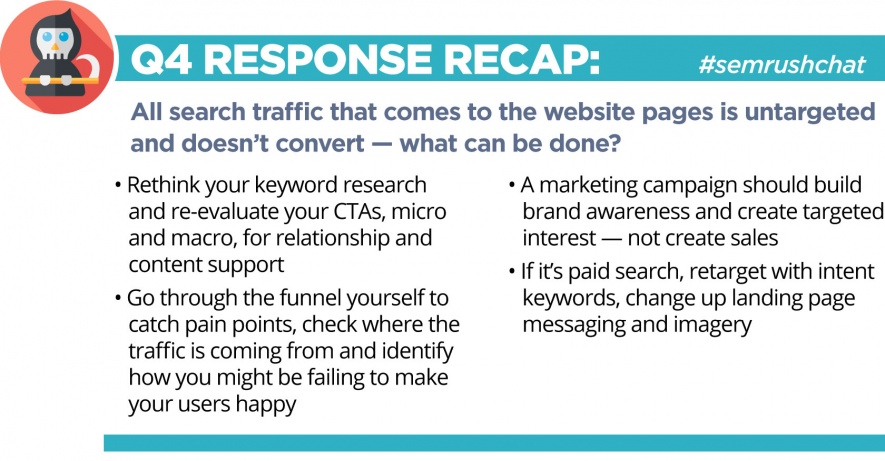
Of course, this is not the ultimate list of tips for increasing conversions. However, these simple, yet actionable techniques can help you to dive deeper and discover important information that will make your strategy more informed and effective.
Q5. Your CTA isn't getting any traction, how do you track the user behavior and see if it's a placement issue or something else?
A/B Testing
Many of our chat participants recommend creating an A/B test to judge the effectiveness of several versions of the same CTA. By testing these platforms, you are eliminating the need to do guesswork and are making more informed and smart decisions.
A5: You've got some testing to do🔬📊. And, maybe rethink that CTA. Is it your brand, do your clients need it above all else?🤔.🎃.#SEMrushchat
— Viable Operations (@viabledigital) October 25, 2017
A/B testing helps you to compare the data from two different versions of your CTA or your page to understand which one delivers better results. Therefore, testing is an essential way to ensure sustainable success of your marketing campaigns.
A5 I know some people and companies A/B test multiple ads with different copy, CTA etc to see what works best. #semrushchat pic.twitter.com/KS49Meoepc
— Tony Stephan (@SirKingofGifs) October 25, 2017
Make sure to start by testing your copy to figure out whether or not it’s value-driven and how your value proposition resonates with your audience. Don’t forget to test several locations of your CTA button on your page to find the best placement. However, don’t ignore minor elements, even the smallest things matter and can make a big difference. Test different colors and shapes to determine which compositions help to drive more action.
A5: Do some A/B testing with different placements, change copy and investigate everything through heat/click maps. #semrushchat
— Svetlana Stankovic (@salmonseo) October 25, 2017
Event Tracking
You can use event tracking in Google Analytics to monitor the performance of your CTAs. You can track clicks, downloads, flash elements, and other actions that are important to you. If you have a long scrolling page, it may be worth using a scroll tracking plugin to track pixel depth which will help you to uncover how far people are scrolling on your page.
A5 Fire events for other actions like pixel scrolls. If people aren't clicking but are interested, you're pitching the wrong element. #semrushchat
— Tim Welsh (@Twel5) October 25, 2017
User Behavior and Experience
To monitor user behavior, you can use heatmaps, which are insightful tools for graphical representation of where your site visitors are clicking. Hotjar provides powerful heatmaps that can help you to better understand what people want, what they care about, and what they do on your site. You can see and analyze their clicks, taps, and scrolling behavior.
A5: Surprise, we use Hotjar. Heatmaps & Recordings are a great start. Taking a step back, FB ads can be a good first test. #semrushchat
— Hotjar (@hotjar) October 25, 2017
With its click, move, and scroll heatmaps, you not only can determine your visitors’ strongest motivation and desire, but you can also uncover which elements on your page should be leveraged more and which components don’t work at all.
A5) Heatmapping, tracking tool and test, test, test the wording and design of the CTA #semrushchat
— David Rosam (@davidrosam) October 25, 2017
You can also try out FullStory to discover a wealth of information about each user’s experience on your website, such as clicks, keypresses, page transitions, and more.
A5. Our team likes to use digital tools like @fullstory & @googleanalytics to find the disconnect when CTAs don't get traction #semrushchat
— CallRail (@CallRail) October 25, 2017
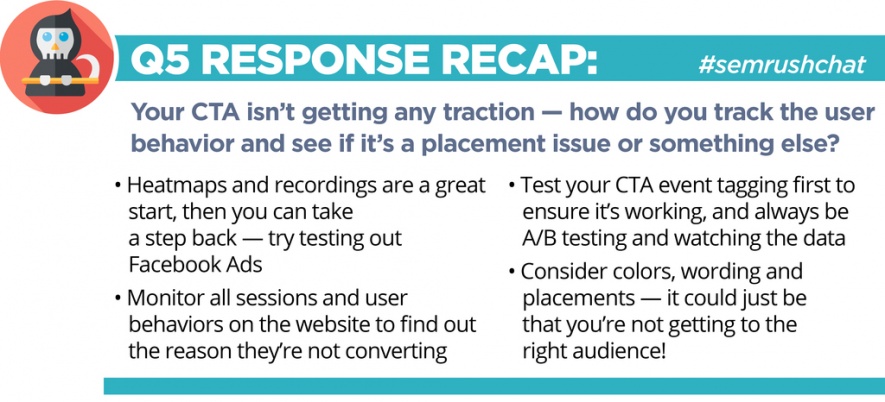
What are some of the techniques and tools you use to track user behavior when your CTA isn’t getting any traction? Share your tips in the comments! We would love to hear about your experience!
Q6. Which web design elements/ CTAs scare customers away the most?
Here are some of the most terrifying web design elements and CTAs that scare customers away:
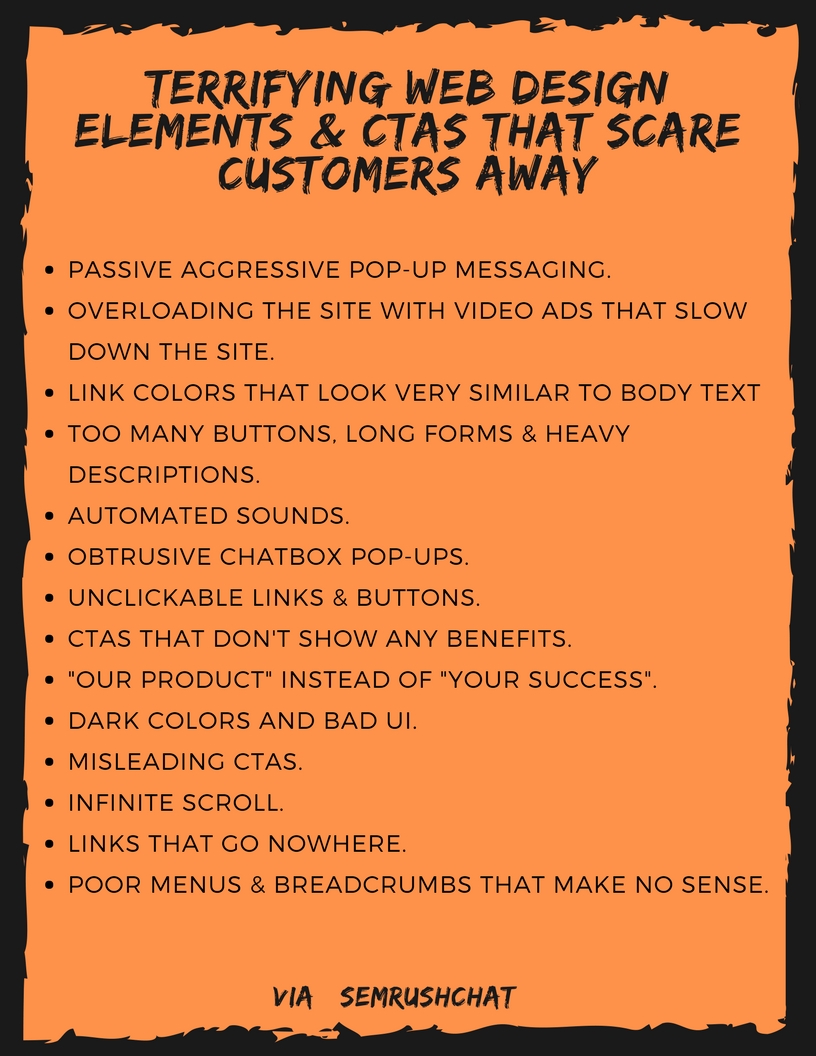
Special thanks to the following chat guests whose tweets we used to make this list: @hotjar, @deren_baker, @dannyraylima, @thomcraver, @salmonseo, @netvantage, @clockworkTalent, @adriana_tica, @SarahAHolder, @R8chel_Marie, @JULScf, @Bronco, @SaadAlikhan1994, and @simoncox.
That’s it for today! Huge thanks to Hotjar and our other chat participants for making this discussion thrilling and useful – don’t let your business nightmares ever come true! Make sure to join us this week as we discuss "The Art of Crafting Successful Facebook Ads" with Susan Wenograd.
Marketing
Like this post? Follow us on Feedly and read more interesting posts:
Follow  Becky Shindell Becky Shindell is the US Social Media Manager at SEMrush and host of the weekly #SEMrushchat. Connect with her on LinkedIn and follow her on Twitter. You can find Becky at many of the US Digital Marketing Conferences, feel free to say hi!Read the original article here
Becky Shindell Becky Shindell is the US Social Media Manager at SEMrush and host of the weekly #SEMrushchat. Connect with her on LinkedIn and follow her on Twitter. You can find Becky at many of the US Digital Marketing Conferences, feel free to say hi!Read the original article here



